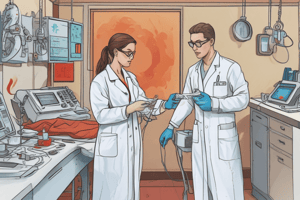Podcast
Questions and Answers
What are the three types of blood collection methods?
What are the three types of blood collection methods?
Arterial, Capillary, and Venipuncture
Which type of blood collection method is performed by a physician?
Which type of blood collection method is performed by a physician?
Arterial puncture
What are the common arterial puncture sites?
What are the common arterial puncture sites?
Radial, Brachial, and Femoral Arteries
What type of blood sample is collected using a lancet?
What type of blood sample is collected using a lancet?
What type of test may require an urgent test?
What type of test may require an urgent test?
What is a specialized tool used in venipuncture?
What is a specialized tool used in venipuncture?
What type of patient may require capillary punctures?
What type of patient may require capillary punctures?
What is the advantage of using capillary punctures?
What is the advantage of using capillary punctures?
What is the purpose of 'milking' in capillary punctures?
What is the purpose of 'milking' in capillary punctures?
What type of syringe is used in venipuncture?
What type of syringe is used in venipuncture?
What is the difference between a 25G and a 21G needle?
What is the difference between a 25G and a 21G needle?
What is the purpose of a tourniquet in venipuncture?
What is the purpose of a tourniquet in venipuncture?
What type of blood tubes are used in capillary punctures?
What type of blood tubes are used in capillary punctures?
What is the purpose of iodine tincture in phlebotomy?
What is the purpose of iodine tincture in phlebotomy?
Flashcards are hidden until you start studying
Study Notes
Blood Collection Methods
- There are three main methods of blood collection: Arterial Puncture, Capillary Puncture, and Venipuncture
- Each method has its own advantages and disadvantages
Arterial Puncture
- Collected by physicians
- Risky, as blood is under pressure
- Used for arterial blood gases, acidity, alkalinity, oxygen, and carbon dioxide measurements
- Common arterial puncture sites include radial, brachial, and femoral arteries
Capillary Puncture
- Uses different types of materials, such as lancets (simple and retractable), automatic (pen devices), and adjustable depths
- Characterized by a small volume of blood, less invasive, and rapid tests/POCT
- Performed using a perpendicular, "milking" motion, at different sites for different patients, and is easier to acquire and perform
Venipuncture
- Uses syringes, evacuated tubes, and needles of different sizes (e.g., 3 ml, 5 ml, 10 ml, 20 ml) and lengths (e.g., 1 inch, 1.5 inch)
- Needles of different gauges (e.g., 21G, 22G, 23G, 25G) are used, with a smaller gauge indicating a larger needle
- Vacutainer hubs are used for ETS (Evacuated Tube System)
Common Phlebotomy Materials
- Capillary puncture materials: gauze (wet and dry), iodine tincture, lancets, micro-capillary tubes, paediatric blood tubes, regular blood tubes, and rapid/POCT devices
- Venipuncture syringe method materials: needles, syringes, gauze (wet and dry), iodine tincture, lancets, regular blood tubes, blood culture bottles, tourniquet, spot bandages, bio bins, and sharp disposal bins
Studying That Suits You
Use AI to generate personalized quizzes and flashcards to suit your learning preferences.




